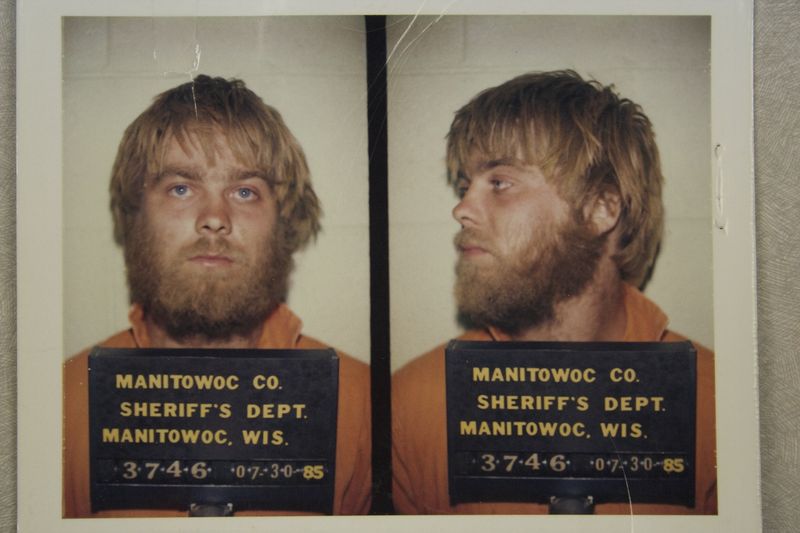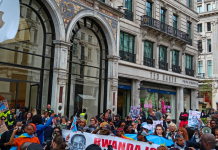Seb Cooke reviews the popular Netflix series, which raises questions that are uncomfortable for those in power and a call to arms for those who are not.

Making a Murderer is not a work of fiction, although you’d be forgiven for thinking it was if you had only heard about it online. Since it became a viral hit, the 10-part documentary has had the kind of treatment usually reserved for major TV dramas. Its characters have been condensed into Gifs and Memes as if they were Walter White and Jesse Pinkman cooking meth in the New Mexico desert. The difference here is that the people at the heart of Making a Murderer are not made up. The death, the trial, the corrupt police force: it’s all horribly real.
The show charts the story of Steven Avery from Manitowoc County, Wisconsin. In 1985 he was wrongly convicted for sexual assault and jailed for 18 years. The documentary begins at the point of his release in 2003, when new DNA evidence proves Steven Avery innocent. It’s big news, and two years later he decides to sue the Manitowoc County and its police force to the tune of $36 Million. As his case is drawing to a successful close, the burnt remains of a woman are found on the Avery family car lot – a vast estate of scrapped vehicles, junk and trailers that are home to different members of the family. The woman is Theresa Halbach, a young photographer who had been seen taking pictures of the Avery estate before her disappearance. The few details we have of her death confirm how horrific it was. She was killed and burnt, and nothing but a few body parts can be a found.
Young women are killed with alarming regularity in TV, to the point where it becomes a sick fetish. In HBO’s much lauded True Detective, the first female character of note to appear in episode one is dead, naked, mutilated and bent over. Women are often reduced to victims, providing not only a sense of horror but also a macho sexual thrill. It’s very rare to see men in these positions. Despite the fact that Making a Murderer is a documentary, and that Theresa Halbach is a real person, it’s hard to ignore the fact that it mixes with a characterisation of women in crime drama that is deeply misogynistic.
The significant difference with this is that it is not the film-makers who exploit Theresa Halbach’s murder, but the police, who appear to move her dead body in order to frame a man who is about to ruin them. The documentary shows how the abuse of this young woman didn’t stop when she was dead; in fact it continues long after at the hands of the state.
The series then follows the trial of Avery for the murder of Halbach, and also focuses on his cousin, Brendan Dassey, who is accused of being an accomplice. In doing so, it paints a vivid story of police abuse and corruption that doesn’t only affect Theresa Halbach, but extends to the whole Avery family, who are regarded by the so-called upstanding members of the community as trouble. The Avery name becomes shorthand for that heavily loaded American term: ‘White trash’. Steven Avery himself is fairly unassuming, protesting his innocence all the way while peacefully going along with events that will determine whether or not he spends the rest of his life in jail.

The case against Steven Avery looks shaky from the start. The central pieces of the prosecution’s evidence are that Theresa Halbach’s car is discovered on the family scrap yard and some of her burnt remains are found in a brazier nearby. The police’s version of events seems straight out of a 70’s thrasher movie: that Steven Avery enticed Theresa Halbach into his trailer where he cut her, tied her to the bed, raped her and finally shot her in the head.
After extensive searches of the property, none of her blood or not a single trace of her DNA is found anywhere. For the police’s version of events to hold true, we are reminded by experts, this is virtually impossible.
Significantly, the court orders that no police officer from Manitowoc County is allowed on the Avery property because of the conflict of interest. Instead, officers from outside the county are brought in. This is breached when two cops from Manitowoc enter Steven Avery’s trailer and quickly discover a key to Theresa Halbach’s car. But the key has no fingerprints and none of her DNA. Oddly, it’s been cleaned. Then, two spots of Avery’s blood are found in her car, but nowhere else. Later we see that a vile of Steven Avery’s blood was taken from the forensics lab by one of the officers from Manitowoc County just before the spots in the car were discovered. It transpires that this is the same officer who reported the car in the first place.
Through the televised courtroom we are invited to see more evidence that shows just how much the prosecution’s case absolutely stinks. The body parts were moved, the DNA samples are invalid, forensics are given clear instructions to manipulate things in the State’s favour, voicemail messages appear to have been deleted. In one shocking moment, an ex-boyfriend is brought before the court. He should clearly be a prime suspect. He even admits to hacking Theresa Halbach’s voicemail and seeing her shortly before she was killed. Astonishingly, he was never even considered a suspect. It’s not unimportant that the police ignore him in this way. Their version of events (the unknown killer) plays into a popular narrative of violence against women that ignores the facts that rape and murder are more likely to be perpetrated by someone that the victim already knows. The police use this inside and outside court, feeding the hungry media a story high on sensation but low on fact.
As each episode goes by, the prosecution’s case seems to slip further into farce. It might seem crude to talk about this as a ‘thriller’, but that is exactly what it is at points. As was the case with OJ Simpson, real life court battles can sometimes be the most compelling and disturbing to watch. But there are fictional references here too. Seeing Steven Avery’s highly capable lawyers pick apart the state’s case is as gripping as anything in Oliver Stone’s dubious account of JFK’s assassination. There are moments to match the infamous ‘magic bullet’ scenario or ‘grassy knoll’ theory so well depicted in that film.
Part of the reason that Making a Murderer has been so wildly popular is because it emulates the fictional world of American justice so effectively. Central to much of this world is the idea that justice can prevail. With the work of brilliant individuals who can make impassioned closing statements, the system can be corrected. What history tells us, however, and as the series reveals, is that American justice rarely delivers. Good rarely defeats Evil.
Evil in this sense is the Manitowoc County Police Deptarmet, who commit appalling acts against innocent people (including Theresa Halbach) so they can avoid being humiliated. Their leader, Kratz, is every bit the villain, the overseer of deep corruption and barbarity. This exposé of the very worst aspects of small town America is nothing new; it is, after all, borne out in the reality of history. The Salem Witch trials, the lynch mobs of the Deep South, and McCarthyism are real examples of American ‘evil’ that have found representation in art. From Arthur Miller’s The Crucible through to Lars Von Trier’s Dogville and even Twin Peaks, the ability for places of apparent innocence to commit murder and worse whilst maintaining a claim to morality is well documented in American culture.
But while this is undoubtedly part of the appeal and shock of Making a Murderer, it would be wrong to characterise one of its central themes as something as mysterious and indefinable as ‘evil’. The truth is much clearer, and has been witnessed several times in very recent memory. What is at the heart of Making a Murder is a depiction of a police force that is corrupt, barbaric, sexist and racist. Michael Brown and Eric Garner are just two cases where the actions of the cops have resulted in something far worse than the wrong committed against Steven Avery, but they are related.
The show avoids making a direct comparison between the racist murders that sparked the #BlackLivesMatter movement and the Avery case. Maybe this is due to the fact the Avery case was back in 2005, 9 years before Michael Brown was shot dead by police in Ferguson, Missouri. But more likely it is because it chooses to focus solely on its subjects: Avery, the police, and small town Wisconsin. Like Fargo, it gives itself more gravity by treating its characters and location as if they were completely isolated and cut off from the rest of the world. Here, as in Fargo, the constant presence of snow provides a cover where disgraceful acts can go unchecked, but the stain of blood nevertheless marks the white exterior.
This is not a point to criticise Making a Murderer for not successfully drawing the links between the two topics. Even documentary is not duty-bound to accurately reflect the nature of oppression. But if it can vividly highlight one aspect of it, then it’s worthwhile. This is what is done here, particularly in the appalling treatment of Avery’s 16-year-old cousin, Brendan Dassey. It’s not lost on the filmmakers, and co-director Laura Ricardi even recently told NME that “the series is timely, given the dialogue Americans are having about the power and integrity of our police forces”.
It’s rare for social or political documentaries to have an impact on their subject matter. One shining exception that proves the rule is Errol Morris’s brilliant noir thriller documentary, The Thin Blue Line. Focussing on a wrongful conviction for the murder of a cop in Dallas in the 1970s, it successfully forced a retrial in the Supreme Court, sparing its main character, Randall Adams, the death penalty. The similarities here are striking, and Making a Murderer stands on the shoulders (or depending how you look at in, in the shadow) of Morris’ masterpiece.
The online reaction this series has elicited has been staggering, and could result in a similar overturned conviction. Here, it’s obvious to see how the show is feeding off and adding to a rapidly growing mistrust of the US police and justice system. This was a driving factor in making the show, with co-director Moira Demos saying recently: “We chose Steven’s story because of the window it could offer onto the criminal justice system. Making A Murderer was always meant to be a social justice film that would raise questions about the system as a whole.”
The questions it raises are uncomfortable for those who are in power and a call to arms for those who are not. The cops got away with it the first time, but the fact that their lies are being exposed to a growing global audience that is now in the millions is perhaps some kind of justice. Whereas before a show would have aired once, it now lives permanently, and for a documentary wanting to make an impact that’s a power the form has never previously enjoyed. Series 2 is now in the pipeline, and with a frenzied audience keeping watch, Manitowoc County Police Department must be feeling pretty shaky.



















I haven’t watched any of series 2 yet but once I had watched the first series, I read around a bit on the case, as I had felt manipulated by the film makers. The problem of how documentaries are made would make a very good film in itself. It seems no one wants to try making them any other way than this rapid cut, through-line narrative method.
Although there was clearly malpractice, corruption and possibly deliberate misplacement of evidence being carried out by the Manitowoc police, I am not as convinced as Seb Cooke about the innocence of Steve Avery in the murder of Teresa Halbach. The documentary makers have cast their die in defending Avery but as evidence mounts about Avery’s probable guilt they seem incapable of giving a balanced view, requiring them to edit and manipulate their footage to sustain their position. I take the point about the need for radical change in the US justice system, but the documentary makers’ approach of drawing lines in the sand will undermine the medium as a motor for driving this change.